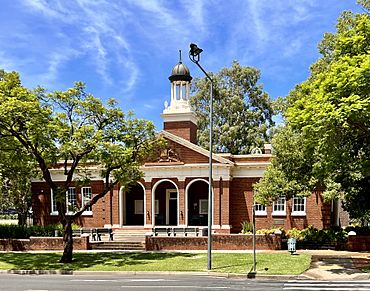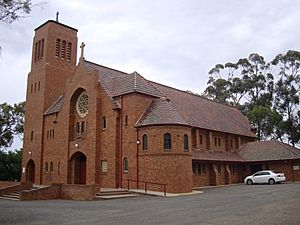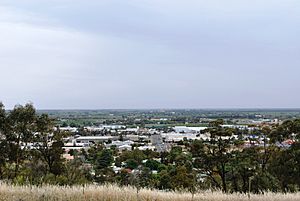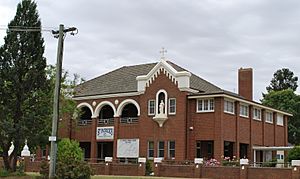Griffith, New South Wales facts for kids
Quick facts for kids GriffithNew South Wales |
|||||||||
|---|---|---|---|---|---|---|---|---|---|

Griffith Court House
|
|||||||||
| Population | 27,321 (2020) | ||||||||
| Established | 4 August 1916 | ||||||||
| Postcode(s) | 2680 | ||||||||
| Elevation | 129.2 m (424 ft) | ||||||||
| Time zone | AEST (UTC+10) | ||||||||
| • Summer (DST) | AEDT (UTC+11) | ||||||||
| Location |
|
||||||||
| LGA(s) | City of Griffith | ||||||||
| County | Cooper | ||||||||
| State electorate(s) | Murray | ||||||||
| Federal Division(s) | Farrer | ||||||||
|
|||||||||
Griffith is a major regional city in the Murrumbidgee Irrigation Area that is located in the north-western part of the Riverina region of New South Wales, known commonly as the food bowl of Australia. It is also the seat of the City of Griffith local government area. Like the Australian capital, Canberra, and extensions to the nearby town of Leeton, Griffith was designed by Walter Burley Griffin and Marion Mahony Griffin. Griffith was named after Arthur Hill Griffith, the then New South Wales Secretary for Public Works. Griffith was proclaimed a city in 1987, and had a population of 20,251 in June 2018.
It can be accessed by road from Sydney and Canberra via the Hume Highway and the Burley Griffin Way and from Melbourne, via the Newell Highway and either by using the Kidman Way or the Irrigation Way. Griffith can be accessed from other places like Adelaide, Orange, and Bathurst through the Mid-Western Highway and the Rankins Springs road from Rankins Springs and the Kidman Way from Goolgowi.
Contents
History
Griffith was established in 1916 as part of the New South Wales State Government's Murrumbidgee Irrigation Area (MIA) project to supply irrigation from the Murrumbidgee river in western New South Wales to be used for farming. The main dam was the large Burrinjuck Dam between Gundagai and Canberra, which stored water to be released down the river for irrigation. Berembed Weir, near Narrandera, was built across the Murrumbidgee River, from which flows the Main Canal. The Canal, almost a river in its own right, flows through the MIA to Griffith, supplying water to the entire area, and petering out to the northwest of the city in rice farms.
The water supply was further enhanced with the construction of the Snowy River scheme by the Australian Federal Government in the 1950s and 1960s. The Blowering Dam, a large dam near Tumut stores a significant amount of water to be released down the Murrumbidgee for irrigation around Leeton, Griffith and the newer Coleambally area south of the Murrumbidgee and Griffith.
From the start of the MIA, citrus and other fruit and vegetables were grown in abundance around Griffith. In the 1950s the irrigation area expanded to include large rice farms. Vineyards were established early, and wineries followed, beginning with McWilliam's Wines at Hanwood and Yenda, two villages just outside the city.
From its earliest days, the MIA was populated by Italian workers, some of whom were initially employed by Australian farmers to run steamboats on the Murrumbidgee and Murray Rivers. Approximately 60% of today's Griffith population claim Italian background. These include the initial settlement of Italians from the boat crews and other Italians who came out to Australia in the Depression, or from a second wave of immigrant Italians who came to Griffith in the late 1950s and early 1960s.
Griffith is associated with good wine and food, primarily as a result of its diverse population, with notable contributions by Italian-Australians. Griffith's multi-ethnic population is now absorbing new national groups, including a significant Sikh Indian community. The city is sister city with the Italian city of Treviso in the Veneto Region. Many Italians in Griffith are from the Veneto Region or the Calabria Region of Italy.
The Italian influence expanded the range of fruit and vegetables, and also significantly increased the number of wineries and the range of wines produced by the existing wineries in the region, such as McWilliam's. De Bortoli, Rosetto and other wineries were established by Italian immigrants, and today they are well known around Australia. In recent times they have been joined by one of the country's best known wine labels, Yellow Tail, produced by Casella Family Brands. Casella, DeBortoli, McWilliam's, Warburn and Berton Vineyards are now among the top 20 wine producers in Australia.
Griffith is the cathedral city of the Anglican Diocese of Riverina. The foundation stone of the Parish Church of St Alban the Martyr was dedicated in 1954. It was proclaimed as a cathedral in 1984.
The city of Griffith had contained no traffic lights up until February 2010 when the first set of traffic lights was installed at the intersection of Burrell Place and Wakaden Street.
Climate
Griffith has a semi-arid climate (BSk) under the Köppen climate classification with hot summers and cool winters. A record high temperature of 46.0 degrees was reached on 23 Jan 2001, while a record low of –6.0 degrees was recorded on 17 July 1977.
| Climate data for Griffith | |||||||||||||
|---|---|---|---|---|---|---|---|---|---|---|---|---|---|
| Month | Jan | Feb | Mar | Apr | May | Jun | Jul | Aug | Sep | Oct | Nov | Dec | Year |
| Record high °C (°F) | 46.0 (114.8) |
45.2 (113.4) |
40.2 (104.4) |
36.1 (97.0) |
28.6 (83.5) |
25.0 (77.0) |
23.0 (73.4) |
30.0 (86.0) |
35.0 (95.0) |
38.3 (100.9) |
43.0 (109.4) |
44.0 (111.2) |
46.0 (114.8) |
| Average high °C (°F) | 32.8 (91.0) |
32.1 (89.8) |
28.8 (83.8) |
24.0 (75.2) |
19.3 (66.7) |
15.5 (59.9) |
14.4 (57.9) |
16.5 (61.7) |
19.8 (67.6) |
23.8 (74.8) |
28.0 (82.4) |
30.8 (87.4) |
23.8 (74.8) |
| Average low °C (°F) | 16.9 (62.4) |
17.3 (63.1) |
14.2 (57.6) |
10.2 (50.4) |
7.2 (45.0) |
4.5 (40.1) |
3.5 (38.3) |
3.9 (39.0) |
5.8 (42.4) |
8.9 (48.0) |
12.5 (54.5) |
15.1 (59.2) |
10.0 (50.0) |
| Record low °C (°F) | 6.8 (44.2) |
7.6 (45.7) |
4.2 (39.6) |
0.0 (32.0) |
−2.0 (28.4) |
−4.0 (24.8) |
−5.9 (21.4) |
−3.3 (26.1) |
−2.0 (28.4) |
0.6 (33.1) |
1.8 (35.2) |
4.2 (39.6) |
−5.9 (21.4) |
| Average precipitation mm (inches) | 33.2 (1.31) |
26.5 (1.04) |
32.9 (1.30) |
27.8 (1.09) |
35.7 (1.41) |
34.1 (1.34) |
33.5 (1.32) |
35.9 (1.41) |
33.2 (1.31) |
39.2 (1.54) |
32.4 (1.28) |
32.7 (1.29) |
397.3 (15.64) |
| Average precipitation days | 4.2 | 3.7 | 3.9 | 4.6 | 6.4 | 7.6 | 9.4 | 9.0 | 7.5 | 6.4 | 5.3 | 4.9 | 72.9 |
| Average relative humidity (%) | 28 | 34 | 37 | 41 | 53 | 63 | 62 | 54 | 47 | 37 | 35 | 31 | 43 |
Demography
In the 2016 Census, there were 19,144 people in Griffith.
- Aboriginal and Torres Strait Islander people made up 5.0% of the population.
- The most common ancestries were Australian 22.4%, English 20.1%, Italian 17.6%, Irish 6.3% and Scottish 5.0%
- 68.3% of people were born in Australia. The next most common countries of birth were India 4.7%, Italy 4.4%, New Zealand 1.8%, Philippines 1.0% and England 0.9%.
- 67.3% of people spoke only English at home. Other languages spoken at home included Italian 7.5%, Punjabi 3.6%, Gujarati 1.2%, Samoan 1.1% and Mandarin 1.1%.
- The most common responses for religion were Catholic 37.4%, No Religion 14.2% and Anglican 12.6%.
Transport
Griffith is a major junction for the Kidman Way, Burley Griffin Way and Irrigation Way. Griffith is located 550 km (340 mi) west of Sydney via Burley Griffin Way and Irrigation Way and 450 km (280 mi) north of Melbourne via the Kidman Way. Griffith has daily bus services to the major metropolitan areas.
Griffith Airport has daily flights to Sydney (operated by Regional Express) and, from 15 July 2019, to Melbourne (operated by Sharp Airlines). There are also regular flights to Broken Hill and Narrandera.
Griffith Buslines operates buses through Griffith and surrounding towns and villages, with seven main services and routes.[1]
The railway reached Griffith on 3 July 1916 and since that date has provided a service transporting passengers and goods to and from the area. Regular goods trains continue, making it a unique railway centre.
Griffith railway station is served by a twice weekly NSW TrainLink Xplorer service from Sydney. NSW TrainLink also operates a daily road coach service from Mildura to Wagga Wagga stopping at Griffith. This service connects at Wagga Wagga with NSW Trainlink rail services to Sydney and Melbourne.
V/Line operates a daily rail/road coach service between Melbourne and Griffith, changing with the train at Shepparton. Melbourne (Southern Cross Station) to Griffith (Bus Terminal at Visitors Centre) is an evening service (daily), and Griffith to Melbourne service is overnight on Monday to Saturday and afternoon on Sunday. Travel time is approximately six and a half to seven hours.
In February 2010, the city’s first set of traffic lights was installed at the intersection of Burrell Place and Wakaden Street to reduce traffic congestion in the Griffith CBD.
Events
- Riverina Field Days, which is held annually in May.
- La Festa, Wine, Food and Multicultural Festival, which is held annually over the Easter weekend.
- Festival of Gardens, which is held annually in October
- Sikh Games, held annually on the June Long Weekend
- unWINEd, held annually on the June Long Weekend
- Multicultural Festival of Griffith - each year in October
- Festa delle Salsicce (Festival of the Sausage) - each year in August
for more events see www.griffith.nsw.gov.au/event.asp
Attractions
Griffith has many tourist attractions. These include Pioneer Park, a 510-seat Regional Theatre, the Italian museum, the Griffith Regional Art Gallery, craft and antique shops, and its many high standard restaurants. Many of the Griffith wineries also have wine tasting at the cellar door, notably De Bortoli Wines, McWilliams, Beelgara Estate (formally Rossetto Wines), West End Wines, Berton Vineyards and Warburn Estate. Griffith is famous for its botrytis including Debortoli's Noble One and its fortified wine such as McWilliam's Hanwood Port. Ecotourism is also available in Griffith. Scenic Hill has various walking trails, lookouts and is home to the famous Hermit's Cave. Nericon Swamp, part of the Griffith Wetlands Important Bird Area, is an important site for migratory birds. Nearby Cocoparra National Park offers walking trails and there are opportunities to explore along the Murrumbidgee River and Lake Wyangan.
Twin towns – Sister cities
Griffith, is twinned with:
 Harbin, China
Harbin, China Comunita Montana del Grappa, Italy
Comunita Montana del Grappa, Italy Fairfield, New South Wales, Australia
Fairfield, New South Wales, Australia
Sports
The most popular sport in Griffith is Rugby League. Griffith is home to two clubs in the Group 20 Rugby League competition, the Griffith Black and White Panthers, and the Griffith Waratahs Tigers. The two clubs are among the most successful in the league with 6 and 13 titles respectively. A third team, the Yenda Blueheelers, based in the small town of Yenda, New South Wales, 15 kilometres from Griffith, also compete in this competition and have won 7 titles and a Clayton Cup as the best team in the state in 2009.
Griffith is also home to the Griffith Swans who compete in the Riverina Football League. They have won one title, in 2003, and have been runners-up many times.
The Griffith and District Football Association (Soccer) has six participating clubs - Griffith City FC, Hanwood FC, West Griffith SC, Yenda Tigers SC, Yoogali FC and Yoogali SC.
Griffith also has a rugby union team, the Griffith Blacks who play in the Southern Inland Rugby Union.
Griffith also has strong local cricket and basketball competitions.
Education
Griffith is the third largest centre for education in the Riverina after Wagga Wagga and Leeton. Griffith is home to three high schools:
- Murrumbidgee Regional High School – MRHS is a super school, made up of two sites, formerly known as Wade High School and Griffith High School
- Marian Catholic College (formerly Catholic High School)
- Verity Christian College - established in 2021
Griffith also has 13 primary schools and various day care and pre-school facilities. Griffith has one of the largest campuses of Riverina Institute of TAFE. There has been recent plans to construct a fifth campus of Charles Sturt University in Griffith.
Notable people
- Andrew Fifita, current Australian rugby league footballer who scored the match winning try in the 2016 NRL Grand Final
- Simon Bonetti, Australian rugby league footballer who played in the 1990s and 2000s, winning a premiership in 2002
- Michael Henderson, Australian rugby league footballer who played in the 2000s and 2010s
- Robbie Simpson, Australian rugby league footballer who played in the 1990s and 2000s
- David Milne, Australian rugby league footballer who played in the 2000s and 2010s
- Esava Ratugolea, Current AFL player for Geelong
- Evonne Goolagong, World No. 1 Australian female tennis player
- Mark Larkham, racing driver
- Trevor Long, Technology Commentator and Today Show Tech Expert was born in Griffith, attended Griffith High School year 7-10.
- Phillip Noyce, director of the 2002 film Rabbit-Proof Fence and the 2010 American film Salt
- Joseph Colpitts, Sgt, Australian Infantry. Fought in nine countries during WWII. Helped rescue many allied soldiers from occupied Crete whilst fighting with the Greek Resistance. Manager of Griffith Baths. Colpitts Place in Griffith is named in his honour.
- Valerio Ricetti, cave-dwelling hermit
Images for kids









